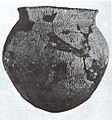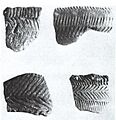Riviere au Vase Site facts for kids
Quick facts for kids Riviere au Vase Site |
|
|---|---|
| Lua error in Module:Location_map at line 420: attempt to index field 'wikibase' (a nil value). | |
| Location | Riviere au Vase near Lake St. Clair |
| Area | 3 acres (1.2 ha) |
The Riviere au Vase site (also called 20MB3) is an important ancient place in southeastern Michigan. It's found in Chesterfield Township, Macomb County, right by the Riviere au Vase river. This river flows into Lake St. Clair. This site is from a time long ago, known as the Late Woodland period, before written history.
Contents
Discovering the Past: Digging at Riviere au Vase
Archaeologists from the University of Michigan started digging at the Riviere au Vase site in 1936 and 1937. Emerson Greenman and George Quimby led these important excavations.
Later, in 1945, Greenman and Victoria Harper wrote articles about the cool things they found. About 20 years after that, another expert named James Fitting studied the pottery from Riviere au Vase. He used it to understand the timeline and culture of the Late Woodland people in southeastern Michigan.
What Archaeologists Found
The digs at Riviere au Vase uncovered many things from the past. They found ancient tools and objects, special pit areas, and even burials of people. They also found animal bones.
Pit Features
Archaeologists found 144 pits at the site. Some of these pits were like ancient trash cans, filled with animal bones and pieces of pottery. These are called "refuse pits."
Ancient Burials
A total of 145 burial areas were found, containing the remains of about 350 people. Some of these were "ossuaries," which are places where many bones are gathered together.
Some burials even had extra skulls placed with them. Experts like James Fitting thought these might be "trophy skulls" from enemies. He believed warriors were buried with honor, perhaps with belts holding the skulls of enemies they had defeated.
Animal Bones
Bones from different animals were found in the pits and topsoil. The most common animals were beaver, deer, dog, and various fish. These bones were likely from animals the ancient people ate. They were not made into tools.
Tools and Objects from the Past
Archaeologists found many interesting objects at the site.
- Pottery: They found over 400 pieces of pottery rims, representing 371 different pots!
- Stone Tools: These included arrowheads, scrapers, and drills. There were 38 arrowheads found. The most common type was the triangular Levanna point (15 found), followed by the smaller Madison point (8 found). These points were used with bows and arrows. The use of bows and arrows became much more common during the Late Woodland period, possibly because there was more conflict between groups. Levanna points were popular from about A.D. 900 to A.D. 1350, and then Madison points became more common. Since many Levanna points were found at Riviere au Vase, it suggests the site was used earlier in the Late Woodland period.
- Ground Stone Objects: These included celts (like axes), adzes, and gorgets (decorative necklaces).
- Bone tools: Five awls (sharp tools for piercing) and a perforated turtle shell were found. Also, nine turkey leg bones were found in a burial.
- Clay Animal Figure: A broken clay figure of a small animal was found in a child's burial.
Late Woodland Pottery Styles
Archaeologists love studying pottery because it tells them a lot about ancient cultures. Pottery is often found in large amounts, and its style and decoration can show when and where people lived.
At Riviere au Vase, some whole or nearly whole pots were found, which helped experts understand the different pottery styles. They also looked at rim pieces and unique body pieces to learn more.
Two main groups of Late Woodland pottery were identified: Wayne Ware and Riviere Ware.
Wayne Ware Pottery
Archaeologists found 53 pots of Wayne Ware. These pots usually had a round or slightly long shape with a narrow neck and a rim that flared outwards. They were made with grit (small pieces of rock) mixed into the clay. The rims were usually plain and not decorated. The surface often had a "cordmarked" texture, meaning it looked like cords were pressed into the wet clay.
Wayne Ware is similar to other general "Woodland" pottery types from the time when the Middle Woodland period was changing into the Late Woodland.
Riviere Ware Pottery
A much larger number, 272 pots, of Riviere Ware were found. Riviere Ware pots often had "castellated" (bumpy) or "collared" (thickened) rims. While both Wayne and Riviere Wares used grit, Riviere Ware had coarser (bigger) grit particles.
Four types of Riviere Ware were identified:
- Vase Dentate: 83 pots of this type were found. They were large and round, with cordmarked or fabric-impressed surfaces. They had slanted, vertical, or zigzag patterns along the rim, made with a special stamp or comb. Collared rims were common. This type was also found at the Younge Site in Lapeer County.
- Vase Tool-Impressed: 69 pots of this type were found. They were similar to Vase Dentate, but castellations (bumpy rims) were more common. They were also found at the Younge Site and the Fort Wayne Mound site near Detroit.
- Vase Corded: 78 pots of this type were found. These were similar to Vase Dentate and Vase Tool-Impressed, but they were longer in shape. Their rims were mostly castellated and sometimes collared. This type was found at the Younge Site, Fort Wayne Mound, and the Wolf site.
- Macomb Linear: Only 8 pots of this type were found. They were long with rounded bases, narrow necks, and slightly flared rims. They had castellated rims, sometimes collared, with rough or smoothed cordmarked surfaces. Designs included horizontal lines and triangles. This type was also found at the Younge Site, Fort Wayne Mound, and Wolf sites.
Riviere au Vase and the Younge Tradition
James Fitting created the idea of the "Younge Tradition" (also called the Western Basin). This helps explain a long period of human activity in southeastern Michigan and the western Lake Erie area. This tradition might go back as far as the Archaic Period (around 3000 B.C.) and extends into the Late Woodland Period (around A.D. 1400).
The Late Woodland part of this timeline includes different phases:
- Riviere Au Vase Phase (around A.D. 600-900)
- Younge Phase (around A.D. 900-1100)
- Springwells Phase (around A.D. 1100-1350)
- Wolf Phase (after around A.D. 1250)
The Younge Phase and the Younge Tradition are named after the Younge Site. This was the first place where pottery from this tradition was found.
Based on how pottery styles changed over time, the Younge Site was used a bit later than the Riviere au Vase site.
The Younge Tradition's Late Woodland timeline is similar to other ancient cultures in Canada (like the Glen Meyer and Pickering Early Ontario Iroquois period) and New York state (the Owasco phase). Some experts think these groups might be related because their pottery styles are similar. This suggests the Younge Tradition people might have spoken an Iroquoian language.
Why Riviere au Vase is Important
The Riviere au Vase site was one of the first ancient places to be dug up in southeastern Michigan. The huge collection of pottery found there has been very helpful. It allowed archaeologists to create a timeline and understand the culture of the region. Also, the large number of burials at the site shows us how people honored their dead during this time.
Images for kids






